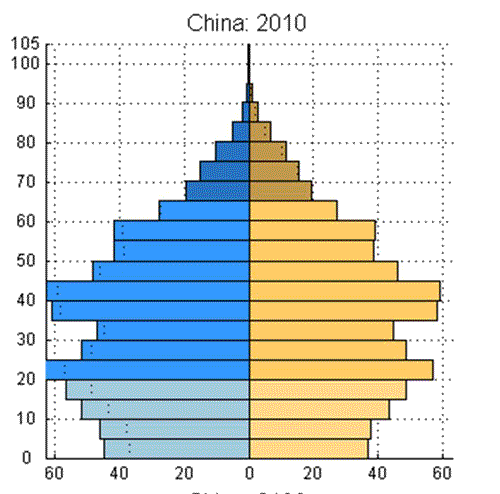As Niels Bohr (and others) observed, prediction is difficult, especially about the future. But if the challenge is predicting the number of 20-year-olds 5 years from now, you can get a pretty darn good start if you know the number of 15-year-olds right now.
And China has more 45- to 50-year-olds today than it has 5- to 10-year olds. That means that in another decade or so, the number of people retiring will be greater than the number of new young people coming into the labor force. For the last ten years, the number of new 20-year-olds was greater in each succeeding year. For the next ten years, the number of new 20-year-olds is going to be fewer in each succeeding year.

China population pyramid as of 2010. Horizontal axis: millions of people (males in blue). Vertical axis: age. Source: World Population Prospects (United Nations)
A slower growth rate and eventual outright decline in the number of people working has to translate into a slower growth rate for total GDP. It also will lead to a number of other changes, such as an increase in wages as compensation to the scarcer factor is bid up. That in turn will undermine the current basis for Chinese competitive advantage, and could mean lots of changes for Chinese society. Perhaps we will be seeing more stories like this one from Monday’s Wall Street Journal:
Hon Hai’s Foxconn Technology Group arm said a fight among several employees in a dormitory late Sunday in the northern province of Shanxi triggered unrest among roughly 2,000 workers that lasted into Monday morning.
Taiwan-based Hon Hai, the world’s largest contract maker of electronics products for such clients as Apple Inc., said 40 people were hospitalized and an unspecified number were arrested….
“Some people are just not satisfied that Foxconn pays us so little and asks us to work long hours,” a female worker said.
Average wages in China’s manufacturing sector rose 18.9% last year, according to China’s National Bureau of Statistics.
“Younger workers are definitely more aware of their rights and more demanding,” said Geoff Crothall, a China Labour Bulletin spokesman. “They want more out of life than simply earning minimum wage.”
A traditional challenge for economies in which a phenomenal economic boom comes to an end is an overhang of investments that were made when it seemed the rapid growth would continue forever but which end up with limited social value. The subsequent sudden drop in spending can then pose significant challenges. Someone watching for this development might be concerned that investment as a percentage of Chinese GDP has been growing over the last decade, and now nears 50% of GDP. Accounts of newly constructed ghost cities with no inhabitants and inventories of unused raw materials also leave some outside observers concerned about whether the country will follow a smooth adjustment path to its inevitable new growth dynamics.

Chinese investment as a percentage of GDP. Data source: World Economic Outlook (IMF)
Disclaimer: This page contains affiliate links. If you choose to make a purchase after clicking a link, we may receive a commission at no additional cost to you. Thank you for your support!


Leave a Reply